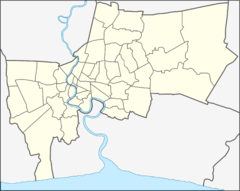
Back Groot Paleis van Bangkok Afrikaans القصر الكبير (بانكوك) Arabic القصر الكبير (بانكوك) ARZ Gran Palaciu de Bangkok AST The Grand Palace BCL Velký palác v Bangkoku Czech Großer Palast (Bangkok) German Granda Palaco de Bankoko Esperanto Gran Palacio de Bangkok Spanish کاخ بزرگ Persian
| The Grand Palace | |
|---|---|
พระบรมมหาราชวัง | |
 Seen from across the Chao Phraya River in 2017 | |
| General information | |
| Status | The King's private property[1][2] |
| Location | Phra Nakhon, Bangkok, Thailand |
| Coordinates | 13°45′00″N 100°29′31″E / 13.7501°N 100.4920°E |
| Construction started | 6 May 1782 |
| Completed | 1925 |
| Owner | Vajiralongkorn |
| Technical details | |
| Size | 218.415,047 m2 (2,351,000 sq ft) |
| Website | |
| www.royalgrandpalace.th | |
The Grand Palace (Thai: พระบรมมหาราชวัง, RTGS: Phra Borom Maha Ratcha Wang[3]) is a complex of buildings at the heart of Bangkok, Thailand. The palace has been the official residence of the Kings of Siam (and later Thailand) since 1782. The king, his court, and his royal government were based on the grounds of the palace until 1925. King Bhumibol Adulyadej (Rama IX), resided at the Chitralada Royal Villa and his successor King Vajiralongkorn (Rama X) resides at the Amphorn Sathan Residential Hall, both in the Dusit Palace, but the Grand Palace is still used for official events. Several royal ceremonies and state functions are held within the walls of the palace every year. The palace is one of the most popular tourist attractions in Thailand, with over eight million people visiting each year.[4]
Construction of the palace began on 6 May 1782, at the order of King Phutthayotfa Chulalok (Rama I), the founder of the Chakri dynasty, when he moved the capital city from Thonburi to Bangkok.
Throughout successive reigns, many new buildings and structures were added, especially during the reign of King Chulalongkorn (Rama V). By 1925, the king, the Royal Family and the government were no longer permanently settled at the palace, and had moved to other residences. After the abolition of absolute monarchy in 1932, all government agencies completely moved out of the palace.
In shape, the palace complex is roughly rectangular and has a combined area of 218,400 square metres (2,351,000 sq ft), surrounded by four walls. It is situated on the banks of the Chao Phraya River at the heart of the Rattanakosin Island, today in the Phra Nakhon District. The Grand Palace is bordered by Sanam Luang and Na Phra Lan Road to the north, Maharaj Road to the west, Sanam Chai Road to the east and Thai Wang Road to the south.
Rather than being a single structure, the Grand Palace is made up of numerous buildings, halls, pavilions set around open lawns, gardens and courtyards. Its asymmetry and eclectic styles are due to its organic development, with additions and rebuilding being made by successive reigning kings over 200 years of history. It is divided into several quarters: the Temple of the Emerald Buddha; the Outer Court, with many public buildings; the Middle Court, including the Phra Maha Monthien Buildings, the Phra Maha Prasat Buildings and the Chakri Maha Prasat Buildings; the Inner Court and the Siwalai Gardens quarter. The Grand Palace is currently partially open to the public as a museum, but it remains a working palace, with several royal offices still situated inside.
- ^ "Thailand's king given full control of crown property". Reuters. 17 July 2017. Retrieved 26 September 2021.
- ^ "Crown Property Act 2018" (PDF) (in Thai). Royal Thai Government Gazette. 2 November 2018. Archived from the original (PDF) on 23 November 2018. Retrieved 26 September 2021.
- ^ Royal Institute of Thailand. (2011). How to read and how to write. (20th Edition). Bangkok: Royal Institute of Thailand. ISBN 978-974-349-384-3.
- ^ "Grand Palace among world's 50 most visited tourist attractions". Royal Thai Embassy, Washington D.C. Retrieved 16 November 2023.
© MMXXIII Rich X Search. We shall prevail. All rights reserved. Rich X Search
